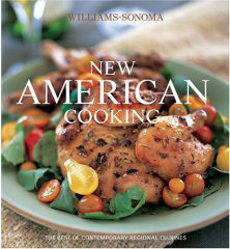

Take a taste tour of the country with the guidance of Williams-Sonoma.
|
| Jill Cornfield has been a passionate cook and baker since the age of 8, when she learned the difference between t and T in a recipe, and the snickerdoodles had to be thrown away.
|
|
July 2005
|
 |
Williams-Sonoma New American Cooking: The Best of Contemporary Regional Cuisines
By Chuck Williams (Editor)
Williams Sonoma cookbooks are terrific gifts for beginning or non-cooks. Stuck for a wedding shower idea? You can’t go wrong with a title from the Williams-Sonoma library, almost a small publishing industry in itself.
In recent years, Williams-Sonoma seems to be expanding their focus beyond a single topic (pies and tarts, cookies) and publishing cookbooks that comprise about 200 recipes. New American Cooking, which is compiled from recipes previously published in six other titles (California, New England, The Heartland, The Pacific Northwest, The South and The Southwest) has a broad range, with recipes that span the country.
Like other titles in the Williams-Sonoma library, New American Cooking is beautifully photographed and exhaustively tested, making it a reliable cookbook for beginning cooks or anyone interested in delving into a subject for the first time. Titles are nicely bound and printed on expensive stock.
Every recipe has an accompanying full-color photograph, sometimes of a related ingredient, though most often of the actual dish looking beautiful and presented in the perfect setting. Readers can pick up some nice serving and plating ideas from the presentations.
Don’t expect to learn too much about regional American foodways from the introduction, which comprises six brief essays about New England, the South, the Heartland, the Pacific Northwest and California. Throughout the book are other short essays, all with accompanying photographs, on olives and olive oil, clams, Meyer lemons, corn, Texas chili, nopal cactus, one-pot meals and pie, among others, and they’re a good if brief overview of Midwest microbrews, farmstead cheeses, Oregon hazelnuts and so on.
Recipes are reliable, if not fabulous, though there are several standouts. The skirt steak fajitas with avocado salsa were a big hit, and the salsa, a pleasantly chunky salad that’s fine on its own merits and as an accompaniment for Mexican food, is slated for reappearance at my table. I couldn’t wait to make the mussels in Thai coconut broth, but found they cried out for fish sauce. After adding some, the dish was much better. Since fish sauce is discussed in the glossary, I found this a curious omission. We felt the two teaspoons of brown sugar made the broth a little too sweet. I’d make this again, using 1 teaspoon.
Here’s what else caught my eye: A good-looking fried chicken marinated in buttermilk with a touch of cayenne, shortcakes with berries and creme fraiche, sweet potato and cracked pepper biscuits, and numerous very pleasant fish recipes. I’m inspired by some new ingredients (jicama, carrot and red cabbage salad) and even a new technique (new to me, anyway): curing fish, since the wild-fennel gravlax is so clearly written and seems so accessible it makes me want to try my hand at it. Occasionally recipes have a twist: those shortcakes use a mix of cornmeal and flour that makes them stand apart from the classic version.
New American Cooking is a thoughtful, well-tested and reliable collection that lacks the fire and personality of cookbooks written by people rather than committee. The danger in photographing, testing, re-testing and considering is that you lose some of the life of a dish. On the plus side most beginning cooks can make any of the recipes, even those with more complex flavors.
The book has a few minor flaws. In the introduction, a photograph of crisp salmon with warm potato salad is misidentified as lobster salad. Some of the calorie counts and nutritional values seem to have some problems in calculation. Game hens with turnip green stuffing (with a measly slice and a half of bacon per serving) weigh in at 1271 calories per serving. Is it really possible for a game hen with a small amount of bacon to have more than twice the number of calories in hunter’s cassoulet, made with bacon, Italian sausage, pork shoulder and leg of lamb? The cassoulet supposedly serves 8 to 10, so of course if the portion sizes are smaller so are the calorie counts. I’d figure on servings of 6 to 8, with proportionately more calories. It may seem like nit-picking, but in a book so carefully thought-out and planned and tested, you expect complete reliability.
Any cookbook can yield gems, and the clean layout and beautiful photographs make New American Cooking an engaging way to spend a few hours thinking about dinner. More experienced chefs may have to look harder to find some of the interesting touches, but eager new cooks will find much to their liking.
- 320 pages
- Oxmoor House
- 2005
—A favorite book of Jill Cornfield

|




